How we test - Diapers
The laboratory testing of diapers is carried out by either SGS Courtray or Eurofins ATS in France, both of which specialize in testing diapers, sanitary pads, incontinence pads and other types of hygiene items. The tests are based on well-established standards and the laboratories' in-house methods.
The laboratory tests include the following parts:
A. Technical characteristics
B. Mechanical characteristics
C. The absorption capacity of the absorbent core
D. Absorption rate
E. Dryness of the skin during daytime use
F. Dryness of the skin during use at night
G. Protection against leakage when the child lies on the stomach and back
H. Protection against leakage in the side position
I. Breathability
J. Softness
Comparative tests are performed on diapers in the same size class.
A. Technical characteristics
Documentation of the diaper's construction, materials in various components, weight and thickness and dimensions. In the evaluation, only the weight and thickness of the diaper is taken into account.
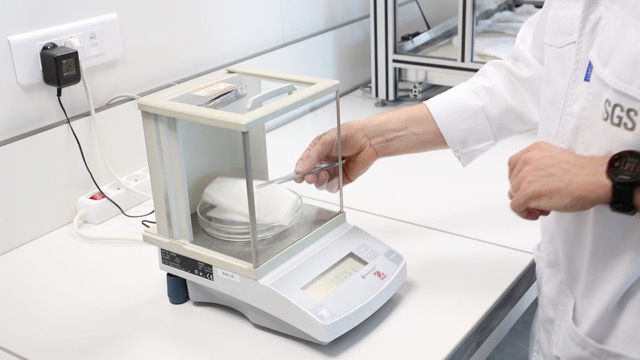
B. Mechanical properties
For pant diapers, the mechanical properties only include the force required to tear open the side panel of the diaper when it is to be removed from the child. For open diapers, the mechanical properties of the tape closure include strength and the force required to release the tape.
The diaper must be able to be opened/torn up without applying too much force, while at the same time it must sit firmly on the child without the risk of loosening when the child moves or pulls on the diaper.

C. The absorption capacity of the absorbent core
The core's total absorption capacity is measured (how much liquid it can absorb). Most diapers have an absorption capacity that far exceeds the needs of a smaller child. The measurement only shows differences in the diaper's technical properties and has nothing or very little to do with the diaper's performance. The result is therefore not included in the evaluation.
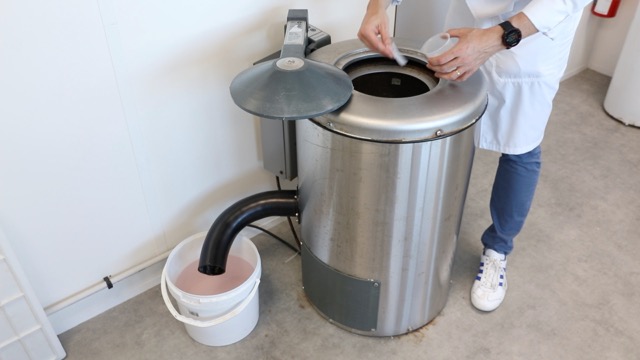
D. Speed of absorption
The diaper's ability to quickly absorb urine. In the test, 75ml of urine is injected in four rounds at 10 minute intervals. The time for absorption of each injection is measured and the highest weight is placed on the time of the first two injections.
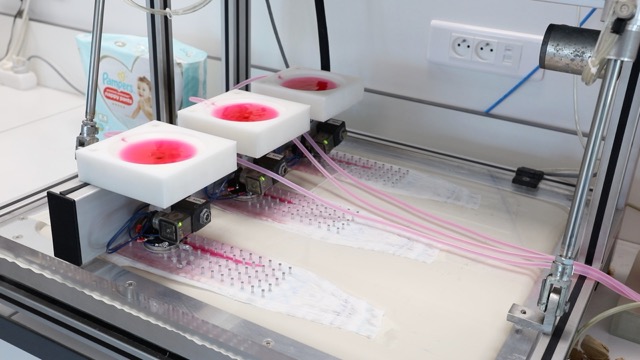
E. Dryness of the skin during daytime use
The nappy's ability to keep dry against the child's skin is simulated for daytime use, i.e. when the child stands, walks and sits. The diaper is placed on a dummy in a standing position and artificial urine is injected into different areas to simulate use on a boy or girl. The moisture against the skin is measured after the diaper has been exposed to a lower pressure for a shorter time.
F. Dryness of the skin during nighttime use
The diaper's ability to keep dry against the child's skin is simulated for use at night, i.e. when the child sleeps. The diaper is placed on a dummy in a supine position and artificial urine is injected into different areas to simulate use on a boy or girl. During the test, the manikin is rotated between supine and prone positions. The moisture against the skin is measured after a pressure load corresponding to the weight of a lying child.
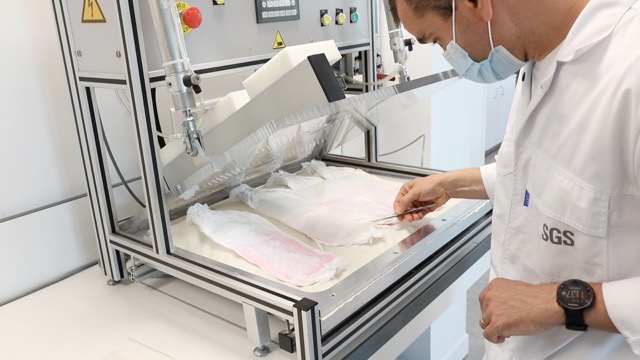
G. Protection against leakage when the child is lying on the stomach and back
The diaper's ability to absorb urine before it starts to leak when the child is lying on their back or stomach during the night. The diaper is placed on a dummy in a supine position and artificial urine is injected into different areas to simulate use on a boy or girl. During the test, the manikin is rotated between supine and prone positions. When the diaper starts to leak, the test is stopped and the amount of urine injected is noted as well as where the leakage occurred.
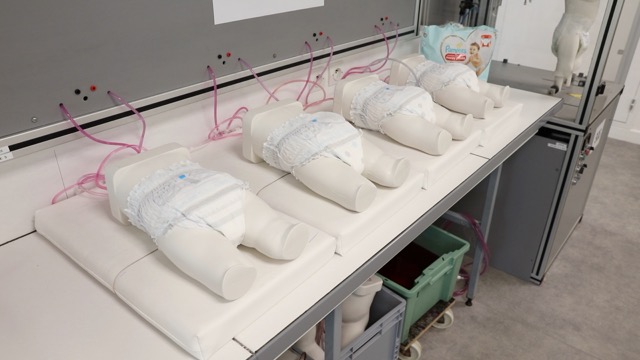
H. Protection against leakage in the side position
The diaper's ability to absorb urine before it starts to leak when the baby is lying on its side at night. The diaper is placed on a dummy and artificial urine is injected when the dummy is on the right or left side. When the diaper starts to leak, the test is stopped and the amount of urine injected is noted as well as where the leakage occurred.
I. Breathability
The diaper's ability to breathe (ventilate away moisture) is tested by measuring the amount of moisture that the diaper emits on the outside.

J. Softness
The softness of the diaper on the inside is measured digitally. The measurement includes the softness of the fibers, the structure of the surface, the density of the surface and how flexible the surface layer is.
Interpretation and grading
The results of the test are interpreted and graded in consultation with the laboratory. The grades are set on a 10-point scale, where 10 is the best. Grades below 6 are only given if the results can be considered bad or significantly worse compared to other products in a comparative test.
The grades for the various parts are weighted together to form a total grade with the following weight:
Protection against leakage: 45%
G. Protection against leakage when the child is lying on the stomach and back: 70%
H. Protection against leakage with the child in the side position: 30%
Dryness to the skin: 25%
E. Dryness of the skin during daytime use: 20%
F. Dryness of the skin during use at night: 60%
D. Absorption speed: 20%
Breathability (I): 10%
Softness (J): 10%
Handling, weight and thickness: 10%
B. Mechanical properties: 50%
C. Weight and Thickness: 50%
Criteria for Testfakta's quality label
Best in test
In a comparative test with the aim of identifying a test-winning product, a representative selection of comparable products (type of diaper and size) is tested for a specific market. The product that performs best overall (highest overall rating) is crowned as "Best in test".

Verified Quality & Performance
In a verification test, the client's diaper is tested individually or against some selected, comparable reference products. Interpretation and grading of the test results follow the same guidelines as above. To qualify for Testfakta Quality & Performance, the diaper must perform consistently well, with a total rating of at least 8.0 (+/- 2.5%) and no partial rating below 6.0 (+/- 2.5%).

